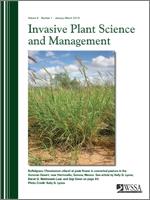Flea beetles (Aphthona spp.) were released in the Little Missouri National Grasslands (LMNG) in western North Dakota in 1999 to control leafy spurge. The changes in leafy spurge density and soil seedbank composition were evaluated on two ecological sites 10 yr (2009) after Aphthona spp. release to monitor the effectiveness of the insects on weed control and the associated changes in plant communities. In 2009, leafy spurge stem density averaged 2 and 9 stems m−2 (0.19 to 0.84 ft−2) in the loamy overflow and loamy sites, respectively, compared with 110 and 78 stems m−2, respectively, in 1999. Leafy spurge constituted nearly 67% of the loamy overflow seedbank in 1999, compared with 2% in 2009. In the loamy seedbank, the weed represented nearly 70% in 1999, compared with approximately 15% in 2009. As leafy spurge abundance was reduced, native species richness and seed count increased 10 yr after Aphthona spp. release. Late seral species represented 17% of the loamy overflow seedbank in 2009, an increase from 5% in 1999. However, Kentucky bluegrass, a nontarget weedy species, increased more than 250% in the loamy overflow seedbank. Late seral species were 38% of the loamy seedbank in 2009, compared with 13% in 1999. The number of native species increased from 31 in 1999 to 39 in 2009 in the loamy overflow seedbank, but only changed from 32 to 34 species in the loamy site during the same period. The reestablishment of native species has been slow, but seedbank analysis indicates the number and type of species found before the leafy spurge infestation have increased. Planting native species in selected areas may have reduced the lag time in these species return to the seedbank and reduced invasion from other nondesirable species, such as Kentucky bluegrass.
Nomenclature: Leafy spurge flea beetle, Aphthona spp.; Kentucky bluegrass, Poa pratensis L.; leafy spurge, Euphorbia esula L. EPHES.
Management Implications: The leafy spurge (Euphorbia esula L.) biological control agents Aphthona nigriscutis and Aphthona lacertosa were introduced to the Little Missouri National Grasslands (LMNG) in western North Dakota in 1999 to control the invasive weed. At the same time, 12 sites each on loamy overflow and loamy soils were established for evaluation of change in leafy spurge density and soil seedbank. In 2009, 10 yr after Aphthona spp. release, leafy spurge stem density had decreased by an average of 94% in the loamy overflow and loamy sites. At the same time leafy spurge seed decreased in the loamy overflow seedbank from 67% in 1999 to only 2% in 2009 and from 70% in 1999 to approximately 15% after 10 yr at the loamy site. As leafy spurge was successfully controlled in the LMNG, native species richness increased in the soil seedbank. Prairie Junegrass was a prevalent native species in the loamy overflow seedbank in 2009, and some late seral species that appeared by 2009 included textile onion (Allium textile A. Nels. & J.F. Macbr.), shy wallflower [Erysimum inconspicuum (S. Wats.) MacM.], locoweed [Oxytropis campestris (L.) DC.], and prairie groundsel [Packera plattensis (Nutt.) W.A. Weber & A. Löve]. However, from 2004 to 2009, there was a substantial increase in Kentucky bluegrass (Poa pratensis L.) in the loamy overflow seedbank. The increase in Kentucky bluegrass was most likely enabled by the reduction in leafy spurge and above-average precipitation, which provided a favorable habitat for growth and invasion. Although Kentucky bluegrass may become a problem species in the LMNG, an increasing trend in native species was observed in the soil seedbank following the reduction of leafy spurge. Desirable forb species and native grasses could be seeded within 5 yr following leafy spurge reduction to reduce opportunistic i





